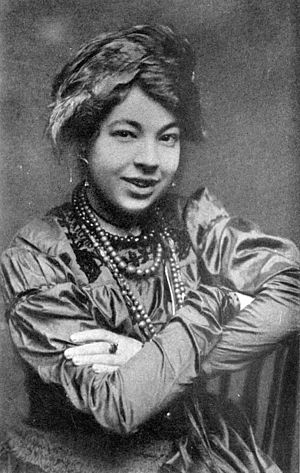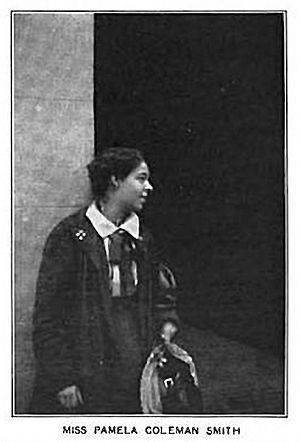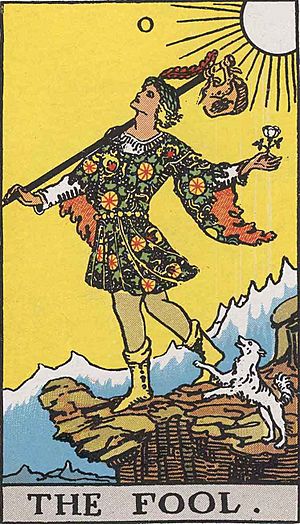Pamela Colman Smith facts for kids
Quick facts for kids
Pamela Colman Smith
|
|
|---|---|

Smith in the October 1912 issue
of The Craftsman magazine |
|
| Born | 16 February 1878 |
| Died | 18 September 1951 (aged 73) Bude, Cornwall, England
|
| Nationality | British |
| Other names | Pixie |
| Occupation | Artist, illustrator, and writer |
| Known for | Waite–Smith tarot deck |
Pamela Colman Smith (born February 16, 1878 – died September 18, 1951) was a talented British artist, illustrator, and writer. She was often called "Pixie" by her friends. Pamela is most famous for drawing the pictures for the Rider–Waite tarot deck. This special deck of tarot cards is still the most popular one used today by people who read tarot.
Besides the tarot deck, Pamela also illustrated more than 20 books. She wrote two collections of Jamaican folk stories and edited two magazines. She even ran her own small publishing company called Green Sheaf Press, which focused on books by women writers.
Contents
Pamela Colman Smith's Life Story
Pamela Colman Smith was born in Pimlico, a part of central London. She was the only child of Charles Edward Smith, a merchant from Brooklyn, New York, and Corinne Colman. Her family lived in Manchester for her first ten years. In 1889, they moved to Kingston, Jamaica, because her father got a job there. They lived in Jamaica for several years, but also traveled to London and New York.
Early Art Education
By 1893, Pamela had moved to Brooklyn. At 15, she started studying art at the Pratt Institute. There, she learned from Arthur Wesley Dow, a famous artist and teacher. Pamela's drawing style was very imaginative. It showed influences from the late 1800s art movements like Symbolism and Romanticism.
While she was at art school, her mother passed away in Jamaica in 1896. Pamela was often sick during these years. She left Pratt in 1897 without finishing her degree. She then began her career as an illustrator. Some of her first projects included a book of poems by William Butler Yeats and a book about actress Dame Ellen Terry. She also wrote and illustrated two of her own books.
Life in London
In 1899, Pamela's father died, leaving her without parents at age 21. She moved back to England that year. She continued her work as an illustrator and also started designing for a small theater. In London, she became close with the Lyceum Theatre group. This group included Ellen Terry, Henry Irving, and Bram Stoker. Pamela traveled with them, helping with costumes and stage designs. Ellen Terry is said to have given Pamela her nickname, 'Pixie'.
In 1901, Pamela opened her own art studio in London. She held weekly open houses where artists, writers, and actors could gather. A writer named Arthur Ransome described these lively gatherings in his 1907 book, Bohemia in London.
Writing and Publishing
Pamela wrote and illustrated two books about Jamaican folk stories. These were Annancy Stories (1899) and Chim-Chim, Folk Stories from Jamaica (1905). These books shared Jamaican versions of tales about Anansi the Spider, a traditional African folk character.
She also kept illustrating books for famous writers like William Butler Yeats and his brother, Jack Yeats. She illustrated Bram Stoker's last novel, The Lair of the White Worm in 1911. She also worked on Ellen Terry's book about the Ballets Russes, a famous Russian ballet company, in 1913.
Pamela supported the fight for women's right to vote. She created artwork for the Suffrage Atelier, a group of illustrators who helped the cause of women's suffrage in Great Britain. During World War I, she also designed posters and toys for the Red Cross to help soldiers.
In 1903, Pamela started her own magazine called The Green Sheaf. It featured works by many artists and writers, including Yeats. The magazine lasted for about a year, with 13 issues. When The Green Sheaf didn't make much money, Pamela started a small press in London in 1904. This was called The Green Sheaf Press. It published novels, poems, and fairy tales, mostly by women writers, until at least 1906.
Art Exhibitions
In 1907, a famous photographer named Alfred Stieglitz showed Pamela's paintings in New York. This was at his gallery, which was usually only for photographs. This made Pamela the first painter to have a show there. Stieglitz was interested in Pamela's unique ability to paint what she saw while listening to music. Her show was very successful. Stieglitz even published a collection of 22 of her paintings. He showed her work two more times, in 1908 and 1909. Some of her unsold paintings are now kept at Yale University.
The Rider–Waite Tarot Deck
Pamela met Arthur Edward Waite through a spiritual group called the Hermetic Order of the Golden Dawn, which she joined in 1901. In 1909, Waite asked Pamela to create a tarot deck that would appeal to artists. The result was the special Waite–Smith tarot deck. It was published by William Rider & Son in London. This deck became the most popular 78-card tarot deck in the world. Its cards were new and exciting because they showed full scenes with people and symbols on every card, even the smaller ones. Pamela's unique drawings have inspired many other tarot decks since then.
After her early success with Stieglitz, Pamela's art didn't find many other commercial opportunities. However, some of her paintings are displayed in Gillette Castle in Connecticut. They were collected by her cousin, the American actor William Gillette.
Later Life and Legacy
In 1911, Pamela became a Roman Catholic. After World War I, she received some money from an uncle. This allowed her to rent a house on the Lizard Peninsula in Cornwall, a beautiful area popular with artists. To earn money, she opened a vacation home for Catholic priests in a nearby house. Her good friend, Nora Lake, helped her run the home.
Pamela faced financial challenges for several years. She moved from the Lizard to Exeter in 1939, and then to Bude in the early 1940s. She continued to write and illustrate, but she found it hard to get her work published. This was probably because public tastes had changed after the war.
Pamela Colman Smith passed away in her apartment in Bude on September 18, 1951. Her belongings were sold to pay her debts. We don't know where she was buried, but it's thought she rests in an unmarked grave in St. Michael's Cemetery in Bude.
The Waite–Smith Tarot Deck
The 78 illustrations in the Waite–Smith tarot deck are like windows into a world of signs and symbols. People believe these symbols can help with understanding things. These drawings are original works of art. Their unique style, drawing, and arrangement make them a great artistic achievement. They show Pamela Smith's amazing imagination for fantasy, fun, strong feelings, and even spooky things.
When Pamela's tarot deck was first published in England in December 1909, it was simply called Tarot Cards. It came with a guide written by Arthur Edward Waite called The Key to the Tarot. The next year, Waite added Pamela's black-and-white drawings to his book and published it as The Pictorial Key to the Tarot.
In 1971, a company called U.S. Games bought the rights to publish the deck. They called it The Rider Tarot Deck. Later, they changed the name to Rider Waite Tarot. Today, many experts call it the Waite–Smith Tarot to honor Pamela's important contribution. Tarot writers often use the short name RWS, which stands for Rider–Waite–Smith.
Over the past century, many different versions of this deck have been printed. Sometimes, other artists redrew Pamela's designs. Other times, the cards were re-photographed for new printing. Many versions have been re-colored because the original colors were a bit harsh due to old printing methods. For example, the 1968 Albano-Waite tarot has brighter colors over the same drawings. Some newer editions have even removed Pamela's hand-drawn titles for each card, using a standard computer font instead.
Who Designed the Deck?
Arthur Edward Waite is often given credit for designing the Waite–Smith Tarot. But it's more accurate to think of him and Pamela as a design team. Waite was in charge of the main ideas, the structure of each card, and the overall system of symbols. Since Waite wasn't an artist, he asked Pamela to create the actual drawings for the deck.
It's likely that Pamela worked from Waite's written and spoken instructions. This is how illustrators often work. It seems Waite gave very detailed instructions for the Major Arcana (the main cards). But for the Minor Arcana (the smaller, numbered cards), he probably only gave simple lists of meanings. This means that the memorable scenes on the Minor Arcana cards were mostly Pamela's own ideas. Her creative illustrations for the Minor Arcana, with their rich symbols, made the Waite–Smith deck a model for many other tarot decks that came after it.
Pamela and Waite used different sources to inspire their designs. Waite likely got his ideas for the Major Arcana from the French Tarot of Marseilles. For the Minor Arcana, Pamela seems to have been inspired by the 15th-century Italian Sola Busca tarot. For example, the 3 of Swords card looks very similar in both decks. There's also evidence that some people in the deck are portraits of Pamela's friends, like actresses Ellen Terry (who might be the Queen of Wands) and Florence Farr (who might be "The World" card).
Pamela finished all the artwork for the deck in just six months, between April and October 1909. This is a short time to create about 80 pictures! She probably used pen and ink, possibly over pencil sketches. The original drawings are now lost. It's unclear if Pamela herself colored them with watercolor or if someone else did it later.
Exhibitions of Her Art
Pamela Colman Smith's art has been shown in several exhibitions after her death.
To All Believers—The Art of Pamela Colman Smith (1975)
An exhibition of Pamela's art was held in the United States in 1975. It was called To All Believers—The Art of Pamela Colman Smith. This show was at the Delaware Art Museum and then at the Art Museum, Princeton University.
Georgia O'Keeffe and the Women of the Stieglitz Circle (2007–2008)
This exhibition featured works by Pamela Smith and other women artists who were active in the art world before the famous artist Georgia O'Keeffe. It helped show O'Keeffe's art in the context of the time. The show traveled to the Georgia O'Keeffe Museum, the High Museum of Art, and the San Diego Museum of Art.
Pamela Colman Smith: Life and Work (2019)
In 2019, the Pratt Institute Libraries in Brooklyn held an exhibition of Pamela's work. It was called Pamela Colman Smith: Life and Work. The show included her books, prints, reproductions of her paintings, tarot decks, and photographs.
Images for kids
-
A World War I-era poster encouraging people to buy a bulldog, with money going to help soldiers. Pamela Colman Smith designed posters for the Red Cross during the war.
See also
 In Spanish: Pamela Colman Smith para niños
In Spanish: Pamela Colman Smith para niños





